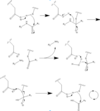User:Luke Edward Severinac/Sandbox 1
From Proteopedia
(Difference between revisions)
| Line 15: | Line 15: | ||
===Structural Units involved in autoactivation=== | ===Structural Units involved in autoactivation=== | ||
| - | Before Caspase-6 is a functional and active dimer, the enzyme exists as a procaspase. This precursor enzyme is modified by self-processing, a characteristic unique to Caspase-6. The unprocessed enzyme contains a small and large subunit, a pro domain, as well as a intersubunit linker. To become active, the intersubunit linker binds to the active site, where it is then cleaved. Other cleavages must occur as well for the enzyme to become active, specifically at TETD23 of the pro-domain | + | Before Caspase-6 is a functional and active dimer, the enzyme exists as a procaspase. This precursor enzyme is modified by self-processing, a characteristic unique to Caspase-6. The unprocessed enzyme contains a small and large subunit, a pro domain, as well as a intersubunit linker. To become active, the intersubunit linker binds to the active site, where it is then cleaved. Other cleavages must occur as well for the enzyme to become active, specifically at TETD23 of the pro-domain, DVVD179, and TEVD193 amino acid sequences. Cleavage at these sites occurs in a specific sequence. To begin, the site within the pro-domain, TETD23, must be cleaved. This cleavage is then followed by either DVVD179 or TEVD193. It has been proposed that this sequence of cleavage is due to the structure of Caspase-6, which allows the pro-domain to be more readily available to enter the active site. To some extent, the pro-domain inhibits Caspase-6's ability to cleave the intersubunit loop and self-activate, but this also happens in a currently unknown mechanism. The pro-domain is released after the cleavage at TETD23, which then allows the two subunits to interact to form the active dimer. |
Caspase-6 can also be activated by other caspases as an alternate to auto-activation. | Caspase-6 can also be activated by other caspases as an alternate to auto-activation. | ||
| - | + | It has been found that Caspase-6 can undergo activation without any other caspases, so there is a suggested self-cleavage mechanism for Caspase-6. The intramolecular cleavage of TEVD193 is essential for the initiation caspase-6 activation without Caspase-3 present. As mentioned above the pro-domain somehow inhibits the intramolecular cleavage of TEVD193, but currently the mechanism is not known. The TETD23 and TEVD193 cleavage sites are extremly similar to one another, but the TETD23 cleavage site is always cleaved before TEVD193. This indicates that the TETD23 cleavage site is more readily available for cleavage. The result of the TETD23 cleavage site priority is that the prodomain acts as a “suicide protector”, which protects the TEVD193 cleavage site from self-cleavage[https://www.ncbi.nlm.nih.gov/pmc/articles/PMC2966951/]. This protection is useful when there are low levels of protein it also helps explain why the pro-domain inhibits self-activation. | |
| - | + | ||
| - | It has been found that Caspase-6 can undergo activation without any other caspases, so there is a suggested self-cleavage mechanism for Caspase-6. The intramolecular cleavage of TEVD193 is essential for the initiation caspase-6 activation without Caspase-3 present. | + | |
| - | + | ||
=='''Inhibition'''== | =='''Inhibition'''== | ||
| Line 55: | Line 52: | ||
Wang, Xiao-Jun, Qin Cao, Yan Zhang, and Xiao-Dong Su. "Activation and Regulation of Caspase-6 and Its Role in Neurodegenerative Diseases." Annual Review of Pharmacology and Toxicology 55.1 (2015): 553-72. Web. | Wang, Xiao-Jun, Qin Cao, Yan Zhang, and Xiao-Dong Su. "Activation and Regulation of Caspase-6 and Its Role in Neurodegenerative Diseases." Annual Review of Pharmacology and Toxicology 55.1 (2015): 553-72. Web. | ||
| - | + | Wang XJ, Cao Q, Liu X, Wang KT, Mi W, et al. 2010. Crystal structures of human caspase 6 reveal a new mechanism for intramolecular cleavage self-activation. EMBO Rep. 11: 841–47 | |
| + | (self cleavage article) | ||
http://www.rcsb.org/pdb/explore/explore.do?structureId=2WDP (this is the non-self cleaved protien) | http://www.rcsb.org/pdb/explore/explore.do?structureId=2WDP (this is the non-self cleaved protien) | ||
Revision as of 21:59, 2 April 2017
Caspase-6 in Homo sapiens
| |||||||||||
References
Wang, Xiao-Jun, Qin Cao, Yan Zhang, and Xiao-Dong Su. "Activation and Regulation of Caspase-6 and Its Role in Neurodegenerative Diseases." Annual Review of Pharmacology and Toxicology 55.1 (2015): 553-72. Web.
Wang XJ, Cao Q, Liu X, Wang KT, Mi W, et al. 2010. Crystal structures of human caspase 6 reveal a new mechanism for intramolecular cleavage self-activation. EMBO Rep. 11: 841–47
(self cleavage article)
http://www.rcsb.org/pdb/explore/explore.do?structureId=2WDP (this is the non-self cleaved protien)



